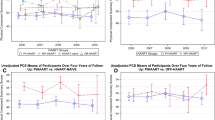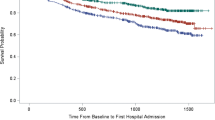Abstract
We review applications of the Quality of Well-Being (QWB) scale for use in studies of human immunodeficiency virus (HIV)-infected patients. The QWB scale is a preference-weighted decision theory-based measure that summarizes outcomes in terms of quality-adjusted life years (QALYs). In order to validate the QWB scale for HIV-infected patients, the measure was administered in the University of California, San Diego (UCSD) HIV Neural Behavioral Research Center (HNRC). Data are presented for a cohort of 400 HIV-positive-infected men and 114 HIV-uninfected male controls. The evidence suggests that the QWB scale is a significant prospective predictor of mortality. The QWB scale was concurrently associated with the number of CD4+ lymphocytes and ratings of neurological impairment based upon clinical evaluations. Further, the QWB scale was related to neuropsychological assessments derived from formal tests of cognitive functioning. Neuropsychological impairments may be associated with income loss for affected patients. The QWB scale scores were lower among patients with clinical depression. We conclude that the QWB scale is an appropriate general health outcome measure for use in observational studies and clinical trials for patients with HIV disease.
Similar content being viewed by others
References
Hays RD, Shapiro MF. An overview of generic health related quality-of-life measures for HIV research. Qual Life Res 1992; 1: 91–97.
Lubeck DP, Fries JF. Changes in quality of life among persons with HIV infection. Qual Life Res. 1992; 1: 359–366.
Wachtel T, Piette J, Mor V, Stein M, Fleishman J, Carpenter C. Quality of life in persons with human immunodeficiency virus infection: measurement by the Medical Outcomes Study instrument Ann Intern Med 1992; 116(2): 129–137.
Schag CA, Ganz PA, Kahn B, Petersen L. Assessing the needs and quality of life of patients with HIV infection: development of the HIV Overview of Problems-evaluation System (HOPES). Qual Life Res 1992; 1: 397–413.
Ganz PA, Coscarelli Schag CA, Kahn B, Petersen L, Hirji K. Describing the health-related quality of life impact of HIV infection: findings from a study using the HIV Overview of Problems-evaluation System (HOPES). Qual Life Res 1993; 2: 109–119.
Hays RD, Wu AW, Cleary PD, et al. Associations of time tradeoff with health-related quality of life profile measures in HIV disease (abstract). AHSR FHSR Ann Meet Abstr Book 1996; 13: 93–94.
Cunningham WE, Bozzette SA, Hays RD, Kanouse DE, Shapiro MF. Comparison of health-related quality of life in clinical trial and nonclinical trial human immunodeficiency virus-infected cohorts. Med Care 1995; 33: AS15–AS25.
Wu AW, Coleson LC, Holbrook J, Jabs DA. Measuring visual function and quality of life in patients with cytomegalovirus retinitis. Development of a questionnaire. Studies of Ocular Complication of AIDS Research Group. Arch Ophthalmol 1996; 114: 841–847.
Copfer AE, Ampel NM, Hughes TE et al. The use of two measures of health-related quality of life in HIV-infected individuals: a cross-sectional comparison. Qual Life Res 1996; 5: 281–286.
Revicki DA, Simpson KN, Wu AW, LaVallee RL. Evaluating the quality of life associated with rifabutin prophylaxis for Mycobacterium avium complex in persons with AIDS: combining Q-TWiST and multiattribute utility techniques. Qual Life Res 1995; 4: 309–318.
Kaplan RM. An outcomes-based model for directing decisions in women's health care. Clin Obstet Gynecol 1994; 37(1): 192–206.
Berzon R, Patrick D, Guyatt G, Conley JM. Intellectual property considerations in the development and use of HRQL measures for clinical trial research. Qual Life Res 1994; 3: 273–277.
Revicki DA, Kaplan RM. Relationship between psychometric and utility-based approaches to the measurement of health-related quality of life. Qual Life Res 1993; 2: 477–487.
Siegel JE, Weinstein MC, Russell LB, Gold MR. Recommendations for reporting cost-effectiveness analyses. Panel on Cost-effectiveness in Health and Medicine. JAMA 1996; 276: 1339–1341.
Gold MR, Siegel JE, Russel LB, Weinstein MC. Cost-effectiveness in Health and Medicine. New York: Oxford University Press, 1996.
Kaplan RM, McCutchan JA, Navarro AM Anderson JP. Quality adjusted survival analysis: a neglected application of the Quality of Well-being scale. Psychol Health: Int J 1994; 9: 131–141.
Kaplan RM, Bush JW, Berry CC. Health status: types of validity and the index of well-being. Health Service Res 1976; 11(4): 478–507.
Kaplan RM, Anderson JP. A general health policy model: update and applications. Health Service Res 1988; 23: 203–234.
Kaplan RM, Anderson JP. The Quality of Well-being scale: rationale for a single quality of life index. In: Walker S, Walker R, Rosser R, eds. quality of life Assessment and Application. London: MTP Press, 1988: 51–77.
Kaplan RM, Bush JW Berry CC. Health Status Index: category rating versus magnitude estimation for measuring levels of well-being. Med Care 1979; 17(5): 501–525.
Kaplan RM. Human preference measurement for health decisions and the evaluation of of long-term care. In: Kane R, Kane L, Kane RA, eds. Values and Long-Term Care. Lexington, MA: Lexington Books, 1982: 157–188.
Kaplan RM. Quality of life assessment for cost/utility studies in cancer. Cancer Treat Rev 1993; 19 (Suppl A): 85–96.
Erickson P, Kendall EA, Anderson JP, Kaplan RM. Using composite health status measures to assess the nation's health. Med Care 1989; 27 Suppl 3: S66–S76.
McHorney CA. Measuring and monitoring general health status in elderly persons: practical and methodological issues in using the SF-36 Health Survey. Gerontologist 1996; 36: 571–583.
McHorney CA, Kosinski M, Ware JEJ. Comparisons of the_ costs and quality of norms for the SF-36 health survey collected by mail versus telephone interview: results from a national survey. Med Care 1994; 32: 551–567.
Anderson JP, Bush JW, Berry CC. Internal consistency analysis: a method for studying the accuracy of function assessment for health outcome and quality of life evaluation. J Clin Epidemiol 1988; 41: 127–137.
Anderson JP, Bush JW, Berry CC. Classifying function for health outcome and quality-of-life evaluation. Self versus interviewer modes. Med Care 1986; 24: 454–469.
Anderson JP, Kaplan RM, Berry CC, Bush JW, Rumbaut RG. Interday reliability of function assessment for a health status measure. The Quality of Well-being scale. Med Care 1989; 27: 1076–1083.
Tarlov AR, Ware JEJ, Greenfield S, Nelson EC, Perrin E, Zubkoff M. The Medical Outcomes Study. An application of methods for monitoring the results of medical care. JAMA 1989; 262: 925–930.
Stewart AL, Hays RD, Wells KB, Rogers WH, Spritzer KL, Greenfield S. Long-term functioning and well-being outcomes associated with physical activity and exercise in patients with chronic conditions in the Medical Outcomes Study. J Clin Epidemiol 1994; 47: 719–730.
Ware JE, Sherbourne CD. The MOS 36-item short-form health survey (SF-36): conceptual framework and items selection. Med Care 1992; 30: 473–483.
Wu AW, Rubin HR, Mathews WC, et al. Functional status and well-being in a placebo-controlled trial of zidovudine in early symptomatic HIV infection. J AIDS 1993; 6(5): 452–458.
Burgess A, Dayer M, Catalan J, Hawkins D, Gazzard B. The reliability and validity of two HIV-specific health related quality-of-life measures: a preliminary analysis. AIDS 1993; 7(7): 1001–1008.
Bozzette SA, Hays RD, Berry SH, Kanouse DE, Wu AW. Derivation and properties of a brief health status assessment instrument for use in HIV disease. J AIDS Human Retrovirol 1995; 8(3): 253–265.
Heaton RK, Kirson D, Velin RA, Grant I. Utility of clinical ratings for detecting cognitive change in HIV infection. In: Grant I, Martin A, eds. Neuorpsychology of HIV Infection. Oxford Universtiy Press, 1994: 188–206.
Gullivich SJ, Kalmijn JA, Thal LJ et al. Sensory testing in HIV-I infected men. Arch Neurol 1992; 49: 1281–1284.
Hamilton MA. Development of a rating scale for primary depressive illness. Br J Soc Clin Psychol 1967; 6: 278–196.
Beck AT. Cognitive Therapy and the Emotional Disorders. New York: Hoeber, 1976.
Heaton RK, Marcotte TV, White DA, et al. Nature and vocational significance of neuropsychological impairment associated with HIV infection. Clin Neuropsychol 1996; 10(1): 1–14.
Kerner DN, Grant I, Atkinson JH, Hesselink J, McCutchan, A, Kaplan RM. Psychosocial and biological predictors of mortality in HIV-infected adults. Ann Behav Med 1996.
Rubin HC, Patterson TL, Atkinson JH et al. Tracking effects of depression on life quality in HIV. In: Second International Conference on AIDS Impact, Brighton UK, 7–10 July 1994.
Kaplan RM, Anderson JP, Patterson T. Validity of the Quality of Well-being scale for persons with human immunodeficiency virus infection. HNRC Group. HIV Neurobehavioral Research Center. Psychosomat Med 1995; 57(2): 138–147.
Author information
Authors and Affiliations
Rights and permissions
About this article
Cite this article
Kaplan, R.M., Patterson, T.L., Kerner, D.N. et al. The Quality of Well-Being scale in asymptomatic HIV-infected patients. Qual Life Res 6, 507–514 (1997). https://doi.org/10.1023/A:1018456031659
Issue Date:
DOI: https://doi.org/10.1023/A:1018456031659




